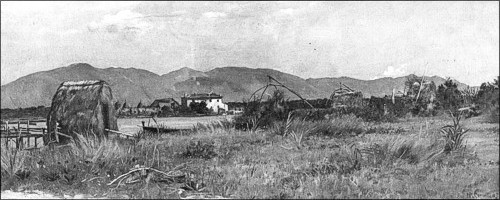|
|
 |
|
| Mattew Ridley Corbet Near the Mouth of the River Arno, 1885 |
|
|
|
|
Costa e i suoi seguaci cercavano il sentimento nella natura, scartando la precisione topografica del vedutismo e il realismo lenticolare della visione ruskiniana. I principi della Scuola Etrusca furono elaborati da Costa e George Mason nella Campagna romana negli anni Cinquanta.
Un buon numero di artisti anglo-italiani, professionisti e dilettanti, nell’inverno 1883-84 si raccolse attorno alla carismatica figura di Costa: George Howard, William Blake Richmond, Edgar Barclay, Walter MacLaren, Walter James, Matthew Ridley Corbet e sua moglie Edith Murch; oltre a Napoleone Parisani, Norberto Pazzini e Gaetano Vannicola.
Simpatizzavano con le linee guida della Scuola Etrusca anche gli inglesi Walter Crane e Thomas Armstrong, nonché gli americani Eugène Benson e Elihu Vedder. I luoghi d’ispirazione prediletti dalla Scuola erano la Campagna romana e il paesaggio vicino a Bocca d’Arno, dove Costa teneva un cenacolo estivo fin dal 1885, che comprendeva anche le montagne di Carrara e i colli pisani: fu coniato dagli intimi addirittura il termine “boccadarneggiare”.
Gli artisti del gruppo prediligevano tavole di formato oblungo, con scene illuminate dalla luce dell’alba o del tramonto e con colori subordinati alla suggestione atmosferica. Per qualche anno attorno al 1885 la Grosvenor Gallery ospitò i membri della scuola, consentendone una sorta di identificazione, che produsse perfino una sua “bibbia”. Tra i precetti seri e semiseri, questa specie di manifesto di gruppo prediligeva la scelta di mettere il tono più scuro non in primo piano, come répoussoir, ma al centro della composizione, un espediente che consentiva meglio l’articolazione dello stesso. Negli anni Novanta emersero i primi segni di fastidio critico nei confronti della Scuola, a causa del ripetersi di motivi ormai obsoleti. Comunque, l’energia rimasta confluì in “In Arte Libertas”, un’associazione internazionale, nata a Roma nel 1885-86, sempre grazie allo spirito innovatore di Costa, che era in qualche modo precursore della Biennale di Venezia, inaugurata dieci anni dopo.
|
|
|
Nino Costa and his followers sought to find sentiment in nature, rejecting both the topographical precision of perspective views and the lenticular realism dear to Ruskin: Costa and George Mason originally elaborated the principles of the Etruscan School in the Roman Camagna in the 1850s.
A fair number of Anglo-Italian artists, both professionals and amateurs, rallied round the charismatic figure of Costa during the winter of 1883-84: George Howard, William Blake Richmond, Edgar Barclay, Walter Maclaren, Walter James, Matthew Ridley Corbet and his wife Edith Murch ; also Napoleone Parisani, Norberto Pazzini and Gaetano Vannicola. Walter Crane and Thomas Armstrong were sympathetic towards the main ideas of this so-called Etruscan School, in addition to the Americans, Eugéne Benson and Elihu Vedder.
The favoured places for inspiration were the Roman Campagna and the landscape around Bocca d’Arno where, as from 1885, Costa held a sort of summer school. The area included the Carrara Mountains and the hills of Pisa. The intimates coined the term “boccadarneggiare” for the sojourn.
This group of artists had a special predilection for oblong wooden panels, the scenes being illuminated by the light of dawn or sunset, and the colours subordinated to the suggestive effects of the atmosphere. For some years around 1885, the Grosvenor Gallery in London hosted members of the School, thus contributing to its identification. It even produced its own “Etruscan Bible”. Amongst the various serious and semi-serious precepts enunciated was that of putting the darkest tone not in the foreground, as a répoussoir, but in the centre of the composition, an expedient that favoured a more subtle articulation of the picture planes.
During the 1890s the first signs of critical intolerance emerged, provoked by the repetition of motives that had become obsolete. However, the remaining energy now fuelled In Arte Libertas, an international association founded in Rome in 1885-86, largely thanks to Costa’s innovatory spirit, which was in some ways a precursor of the Venice Biennale inaugurated ten years later.
|
|
|
|
|
|